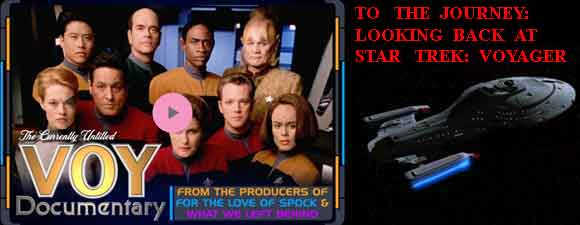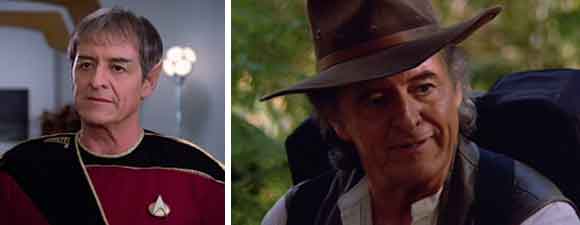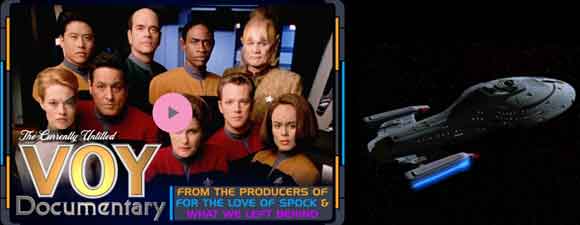Retro Review: Scorpion, Part I
7 min read
scorpion1banner
Voyager reaches Borg space and finds a region free of cubes, but home to an even more deadly menace.
Plot Summary: While Janeway is exploring art and science on the holodeck with Leonardo da Vinci, she receives a summons. One of the ship’s long range probes has been discovered and destroyed by the Borg. Realizing that Voyager has not only reached Borg space but very likely come to the attention of the Collective, the crew tries to plot a safe course, discovering a narrow corridor where there appears to be no Borg activity. They soon learn why, for several Borg cubes pass Voyager at high speed with no more interest than a cursory scan, then are quickly disabled by an adversary unfamiliar to Voyager. Kes can hear the unknown aliens in her mind and fears that they may be more ruthless than the Borg. These new enemies, known to the Borg as Species 8472, create ships out of organic material and enter Borg space through singularities whose origins appear to be outside the galaxy. When Chakotay leads an away team to investigate one of the damaged Borg cubes, a member of Species 8472 injures Kim, infecting him with a condition that slowly alters his DNA to destroy his organs until the desperate Doctor concludes that his only chance is to try using Borg nanoprobes to rewrite the genetic damage. The procedure succeeds and Kim recovers. Faced with either turning away from the most direct route to Earth or risking Voyager in Borg space, Janeway goes to talk to Da Vinci and hits upon the idea of making a deal with the Borg to demonstrate how nanotechnology can work against Species 8472. Chakotay vehemently opposes this plan, believing that the Borg can’t be trusted and it isn’t fair to risk the lives of everyone on the ship, but Janeway chooses to contact the Borg to trade the Doctor’s breakthrough for safe passage through their space. When Janeway threatens to destroy the nanoprobe technology if the Borg threaten her crew with assimilation, the Borg beam her off the bridge, put a tractor beam on Voyager, and flee from an advance by Species 8472.
Analysis: Back when I started retro reviews for Voyager, I made a promise to look at seasons four through seven through a new lens. I wanted to try watching it again with none of the wishes and expectations I carried the first time I saw the Borg arc; in particular, I wanted a fresh take on Seven of Nine. In the years after Voyager, Jeri Ryan became one of my favorite TV actresses – I would not have sat through all those episodes of Shark had it not been for her – so I’m pretty excited to watch the role that made her famous now that I can detach from my initial resistance to the character (whose caricature of a costume I will never stop resenting, but there’s no point in belaboring that every single week). Nothing was ever the same on Voyager after the two parts of “Scorpion” and “The Gift,” so I did something I’ve never done before: I watched all three of them back to back. Having grown up in a pre-DVD and Netflix binge era when one often had to wait months if not years to see a rerun, I sometimes wonder whether my reactions to older shows would have been different if I’d seen them all the way I watched the original Star Trek, which was rebroadcast nearly every weekday afternoon for much of my youth and thus usually cycled through the series twice in a single calendar year – something close to a binge, though often a bit out of order with no way to catch up on a missed episode. Voyager‘s pacing has seemed different to me on this rewatch, with some things rushed, like the Paris/Torres romance when it doesn’t have built-in delays over holidays, and other things less dragged out, like the entire Kazon arc. So because the episodes that end the third season and start the fourth also reinvent the series in a very brief period of series time, I figured it was worth watching them in a closer time frame, not with months stretching from installment to installment.
Taken together, these episodes are as good as any late-era Trek movie. This is a “best of both worlds” scenario not just in its references to the masterful The Next Generation two-parter with that name; it borrows familiar Star Trek themes yet also strikes off into new territory, creating what will ultimately become the most complex arc of the series, the story of Seven of Nine becoming human. While borrowing liberally from (and making references to) things that happened in previous Star Trek series, the writers take the material and make it uniquely Voyager‘s – a show inevitably more invested in the Borg because of its setting than Next Gen, where the Borg are always outside invaders, or Deep Space Nine, where problems closer to home make the Borg threat seem increasingly remote. “Scorpion, Part I” is particularly effective because it’s character-driven by the people we know best, without any Borg yet on the scene, showing us some of the ways Janeway tries to cope with the stress of being in command and the frustrations of crewmembers who can only do their best in extremely trying situations without having the sort of input that Picard gave his crew. I am at this point ambivalent about Janeway’s command style – I think that if she’d leaned too much on others, it would have been labeled a weakness even though Picard called a staff meeting for nearly every major crisis and it’s hard to imagine him dismissing a strong objection by Riker the way Janeway pushes Chakotay’s objections aside. It’s certainly her prerogative, but I can’t help thinking about the captain she becomes, the one from “Night” who hides herself away rather than interacting with subordinates as well as the one from “The Year of Hell” who makes many autocratic decisions as her universe crumbles, so I can’t root for her as wholeheartedly this time around. This command team is much stronger as a team. Da Vinci may be a genius but he’s a ghost here, a projection of her own psyche, not a counter-voice.
Finally we see the Chakotay I always wanted him to be, the one who maintains both his sense of humor about crew impressions of other officers and his convictions that have nothing to do with any Maquis agenda. He knows his role, is never at risk of leading a phantom mutiny like the one from “Worse Case Scenario,” yet he strongly believes that whether the captain gives him a teary guilt trip or not, it’s his responsibility to try to make her see the big picture when he thinks she’s too tired and too single-minded to focus on it. Is it insubordinate to suggest that Captain Ahab’s fixation on a particular whale is bad for him as well as for his crew? As it turns out, Chakotay’s not wrong about not being able to trust the Borg, though the ship is saved by Kes Ex Machina so it ends up being irrelevant. But even without looking for subtext – which is difficult, after Janeway tells Chakotay, “Three years ago, I didn’t know your name. Now I can’t imagine a day without you” – it’s hard not to hear echoes of their arguments on New Earth where she accused him of trying to build a home more than trying to get home and he told her he can’t throw away the present for a future that may never be. Maybe that’s why she addresses his concerns as if they’re engaged in a power struggle rather than both devoted to protecting the crew. Curious that she goes to the holodeck to think rather than to Tuvok, who as chief of security would be the logical person to weigh the pros and cons of pressing into Borg space versus taking a breather to assess other options. In any case, this is the last time we truly see this level of intimate connection between Janeway and Chakotay – as with Kirk and Spock, it’s precisely because they have strong, complicated interpersonal feelings that there’s so much invested in their conflicts. I love Picard’s relationship with Data, I love Sisko’s relationship with Dax, perhaps I’ll even come to love Janeway’s relationship with Seven of Nine, yet a really strong captain-first officer bond has been the center of every Star Trek show but this one, and I will always maintain that Voyager is poorer for its loss.






